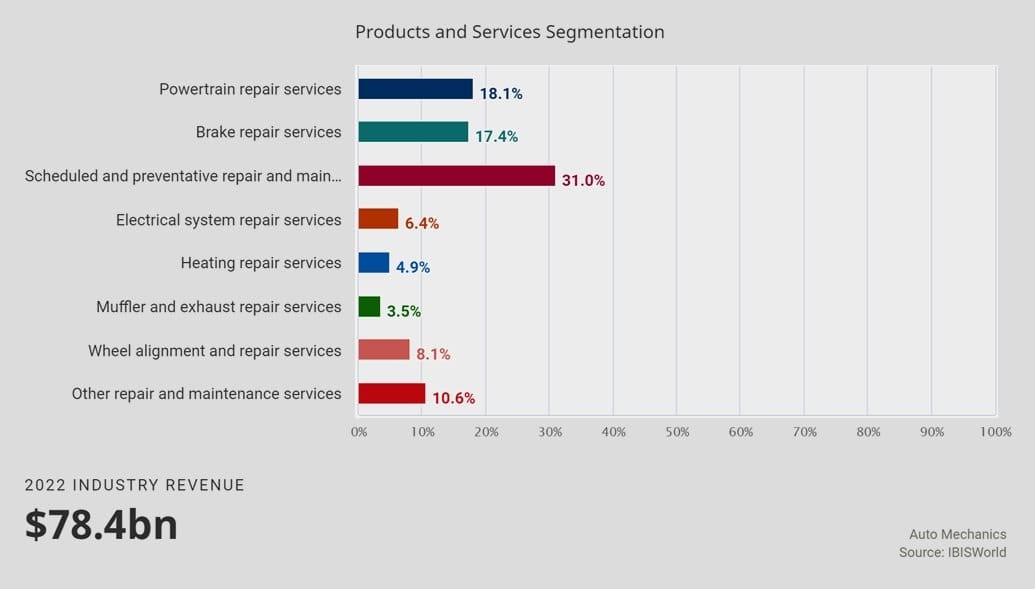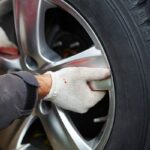Considering turning your passion for cars into a business? Opening an auto repair shop can be a rewarding venture, but one crucial question looms large: how much do auto repair shop owners actually make? It’s a question that blends ambition with practicality, and understanding the financial landscape is key to steering your entrepreneurial dreams in the right direction. This article dives deep into the earnings potential of auto repair shop owners, exploring the factors that influence their income, drawing insights from industry data, and featuring real-world examples like Lucky Sing of Lucky’s Auto Repair, who built a thriving business from the ground up. Whether you’re just starting to explore the idea or are already drafting your business plan, this comprehensive guide will provide you with the essential financial insights you need to make informed decisions and navigate the road to success in the auto repair industry.
Understanding the Revenue Streams and Profitability of Auto Repair Shops
To understand how much auto repair shop owners make, we first need to break down the revenue streams and profitability within the industry. Auto repair shops operate in a competitive market, facing challenges from major national chains to smaller, independent garages. Data from IBIS World, a reputable industry analysis source, reveals key insights into the financial performance of these businesses.
Industry Revenue and Major Players
The auto repair industry is a significant sector, generating billions in revenue annually. While major players like TravelCenters of America, Monro, and Meineke Car Care Centers capture a notable market share, the vast majority of the industry’s revenue and profits are distributed among a large number of independent businesses – approximately 278,000 shops. This indicates a market where smaller businesses can thrive, but also highlights the importance of understanding the competitive landscape.
Average Revenue and Income Potential
Industry averages provide a starting point for understanding income potential. The average auto repair shop brings in around $261,870.50 in annual revenue. However, it’s crucial to understand that this is just an average. The actual income for a shop owner can vary widely based on factors like location, shop size, service offerings, and operational efficiency.
For a sole owner-operator, revenue per employee figures can be insightful. With revenue per employee ranging from $115,000 to $132,000, a single-person operation might generate approximately $10,000 per month in revenue. However, this is revenue, not profit, and doesn’t directly translate to the owner’s take-home pay.
Lucky Sing of Lucky’s Auto Repair offers a compelling real-world example. He projected over $500,000 in revenue with three employees in 2022, translating to roughly $125,000 in revenue per employee (including himself). This demonstrates the potential for exceeding industry averages with effective business strategies.
Decoding Operating Expenses and Profit Margins
Understanding operating expenses is crucial for determining profit margins and, ultimately, the owner’s income. Auto repair shops face a range of costs, including:
- Parts and Other Costs (46.7%): This is the largest expense category, encompassing parts, taxes, IT, professional services, and repairs. Efficient parts sourcing and inventory management are critical for controlling these costs.
- Wages (28.1%): Labor costs are a significant factor. Lucky Sing noted that wages in his experience are closer to $40,000 per mechanic, highlighting potential variations from industry averages and the impact of competitive labor markets.
- Purchases (9.5%): This includes equipment and tools, representing ongoing investments in the shop’s capabilities.
- Rent (4.7%): Location costs can vary significantly depending on geographic area and shop size.
- Marketing (1.9%): While a smaller percentage, effective marketing is essential for attracting and retaining customers.
- Depreciation (1.6%) and Utilities (1.2%): These are smaller but necessary operational costs.
After accounting for these expenses, the average auto repair shop achieves an after-tax profit margin of around 6.3%. Excluding major players, this margin slightly decreases to 6.16%. This means for every $100,000 in revenue, a shop might expect to see approximately $6,160 in profit.
Lucky Sing’s experience again provides a valuable perspective. He reported profit margins around 10%, exceeding the industry average. This highlights the potential to improve profitability through effective management and business strategies, which we will explore further.
Factors Influencing Auto Repair Shop Owner Income
The income of an auto repair shop owner is not fixed; it’s a dynamic figure influenced by a multitude of factors. Understanding these factors is crucial for anyone looking to maximize their earnings in this industry.
Business Size and Scale
The scale of your operation directly impacts your earning potential. A larger shop with multiple bays and technicians can handle more customers and generate higher revenue than a smaller, single-person operation. Expanding your service offerings, such as specializing in specific types of repairs or vehicles, can also attract a broader customer base and increase revenue streams.
Location, Location, Location
The geographic location of your shop plays a significant role. Areas with higher population density, greater vehicle ownership, and less competition can offer more favorable market conditions. However, prime locations often come with higher rent and operating costs, so finding the right balance is crucial. As Lucky Sing mentioned, online presence can mitigate the need for high-traffic locations, but visibility still matters.
Service Specialization and Niche Markets
General auto repair shops cater to a broad range of services, while specialized shops focus on niche markets like transmission repair, brake service, or performance tuning. Specialization can attract a loyal customer base and potentially command higher prices for specialized services. Identifying a profitable niche in your local market can be a strategic advantage.
Operational Efficiency and Cost Management
Efficient shop operations are paramount for maximizing profit. This includes:
- Efficient Parts Procurement: Sourcing parts at competitive prices and managing inventory effectively can significantly impact profitability. Building relationships with multiple vendors, as suggested in the original article, is a key strategy.
- Labor Management: Optimizing technician schedules, minimizing downtime, and ensuring efficient workflow contribute to higher revenue per employee.
- Overhead Control: Managing rent, utilities, and other fixed costs is essential for maintaining healthy profit margins.
- Technology Adoption: Utilizing software solutions for customer relationship management (CRM), diagnostics, and shop management, as highlighted by Lucky Sing’s use of Mitchell1 and Bolt On Technology, can streamline operations and improve efficiency.
Marketing and Customer Acquisition
Attracting and retaining customers is the lifeblood of any business. Effective marketing strategies, both online and offline, are crucial for driving traffic to your shop. This includes:
- Online Presence: A professional website, active social media presence, and positive online reviews are essential for attracting modern customers.
- Local SEO: Optimizing your online presence for local searches ensures that potential customers in your area can easily find your shop.
- Traditional Marketing: Strategies like local advertising, community partnerships, and even innovative approaches like Lucky Sing’s box truck banners can increase visibility.
- Customer Relationship Management: Building strong customer relationships through excellent service, proactive communication, and loyalty programs fosters repeat business and positive word-of-mouth referrals.
Owner’s Skills and Business Acumen
Ultimately, the owner’s skills and business acumen are critical determinants of income. Technical expertise is important, but so are business management skills, including:
- Financial Management: Understanding financial statements, budgeting, and managing cash flow are essential for profitability.
- Leadership and Team Management: Hiring, training, and motivating a skilled and customer-focused team is crucial for shop success.
- Customer Service Excellence: Prioritizing customer satisfaction, as emphasized by Lucky Sing, leads to repeat business and positive reviews, directly impacting revenue.
- Adaptability and Continuous Learning: The auto repair industry is constantly evolving with new technologies and vehicle models. Staying updated with industry trends, investing in training, and adapting to change are essential for long-term success.
Real-World Example: Lucky Sing and Lucky’s Auto Repair
Lucky Sing’s journey with Lucky’s Auto Repair provides a compelling illustration of how to build a successful and profitable auto repair shop. Starting with a modest $20,000 investment in 2016, he has grown his business to generate substantial monthly revenue and achieve profit margins exceeding industry averages. His insights offer valuable lessons for aspiring shop owners.
Key Strategies for Profitability: Lucky’s Approach
Lucky’s success can be attributed to a combination of strategic decisions and a customer-centric approach:
- Focus on Customer Service: Lucky emphasizes prioritizing customer satisfaction, even if it means absorbing costs for misdiagnoses. He understands that happy customers are repeat customers and valuable sources of referrals.
- Investing in Technology: He leverages software solutions like Mitchell1 and Bolt On Technology to enhance diagnostic capabilities, streamline operations, and improve customer communication. This investment, while representing a monthly expense, contributes to increased efficiency and revenue.
- Strategic Marketing: Lucky employs unique marketing strategies like box truck banners to increase visibility and attract customers. He also understands the importance of online presence and customer reviews.
- Employee Empowerment and Training: Lucky prioritizes hiring individuals who care about the business and invests in ongoing training for his mechanics to keep them updated with the latest technologies and customer service best practices. He values his team’s input and incorporates their ideas into his business operations.
- Financial Prudence and Reinvestment: Lucky initially lived frugally and reinvested profits back into the business for growth. He also understands the importance of managing profits effectively for tax optimization and future investments.
Lessons Learned from Lucky’s Experience
Lucky’s journey highlights several key takeaways for aspiring auto repair shop owners:
- Start with a Solid Foundation: While passion for cars is essential, developing industry knowledge, technical skills, and business acumen are crucial for success.
- Customer Service is King: In a competitive market, exceptional customer service is a differentiator and a driver of repeat business.
- Embrace Technology: Technology is no longer optional; it’s a necessity for efficient operations, accurate diagnostics, and effective customer communication.
- Invest in Your Team: Hiring the right people and investing in their training and development is essential for building a high-performing shop.
- Continuous Improvement: The auto repair industry is dynamic. A commitment to continuous learning, adaptation, and improvement is vital for long-term success.
Maximizing Your Income as an Auto Repair Shop Owner
While industry averages and examples like Lucky Sing provide valuable benchmarks, ultimately, your income as an auto repair shop owner will depend on your ability to implement effective strategies and manage your business proactively. Here are key steps to maximize your earnings:
-
Develop a Comprehensive Business Plan: A well-structured business plan is your roadmap to success. It should outline your financial projections, marketing strategies, operational plans, and competitive analysis.
-
Focus on Customer Acquisition and Retention: Implement robust marketing strategies to attract new customers and build loyalty programs to retain existing ones. Exceptional customer service is your most powerful marketing tool.
-
Optimize Pricing and Service Offerings: Conduct market research to determine competitive pricing for your services. Consider offering value-added services and packages to increase revenue per customer.
-
Implement Efficient Shop Management Practices: Streamline your operations, manage inventory effectively, and utilize technology to improve efficiency and reduce costs.
-
Control Expenses and Improve Profit Margins: Scrutinize your expenses regularly and identify areas for cost reduction without compromising quality. Negotiate favorable terms with suppliers and optimize labor costs.
-
Invest in Employee Training and Development: A well-trained and motivated team is more productive and delivers higher quality service, contributing to increased revenue and customer satisfaction.
-
Monitor Financial Performance and Adapt: Track your key performance indicators (KPIs) regularly, analyze financial reports, and adapt your strategies based on performance data and market trends.
-
Seek Continuous Learning and Industry Knowledge: Stay updated with industry trends, new technologies, and best practices. Attend industry events, participate in training programs, and network with other shop owners.
Conclusion: Taking Control of Your Earning Potential
So, how much do auto repair shop owners make? The answer is multifaceted and depends on a range of factors. While industry averages provide a general range, the real potential lies in your ability to build a well-managed, customer-centric, and efficient operation. By understanding the revenue streams, controlling expenses, implementing effective strategies, and continuously adapting to the market, you can significantly influence your income and build a thriving and profitable auto repair business. The journey of Lucky Sing and the data-driven insights discussed in this article serve as a valuable guide for navigating the path to financial success as an auto repair shop owner. The road to profitability requires dedication, smart decisions, and a commitment to excellence, but for those with the drive and business acumen, the rewards can be substantial.



